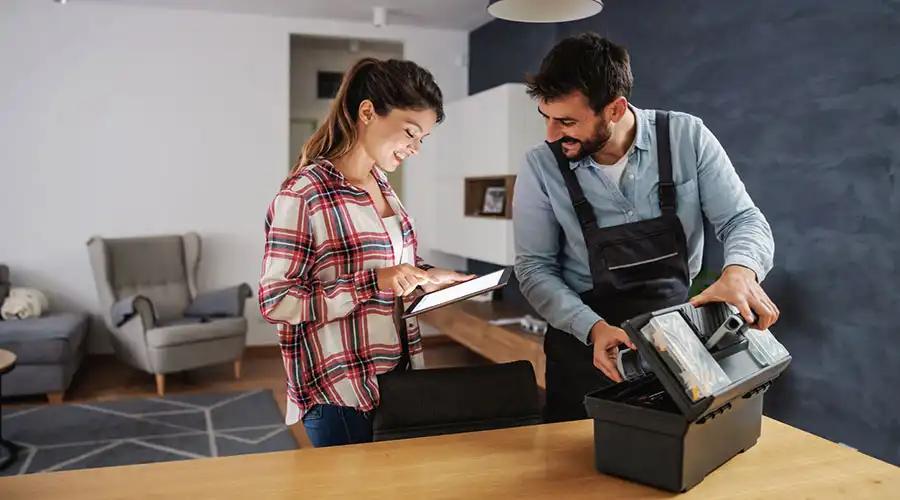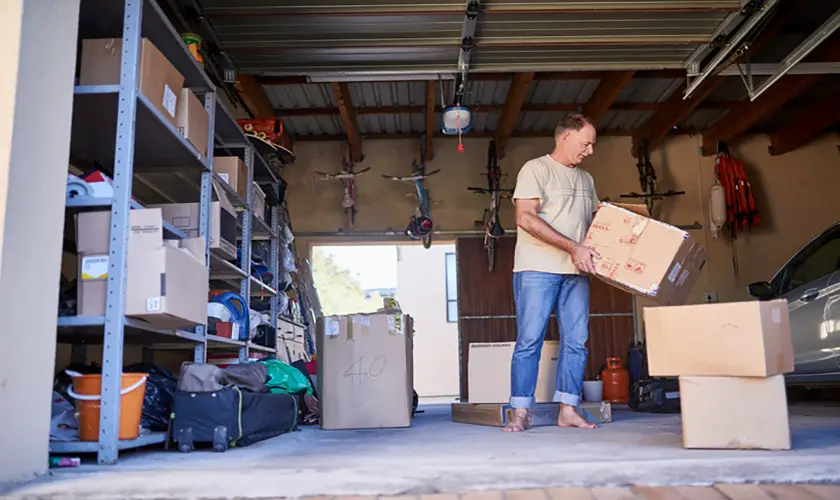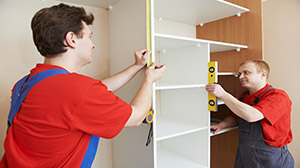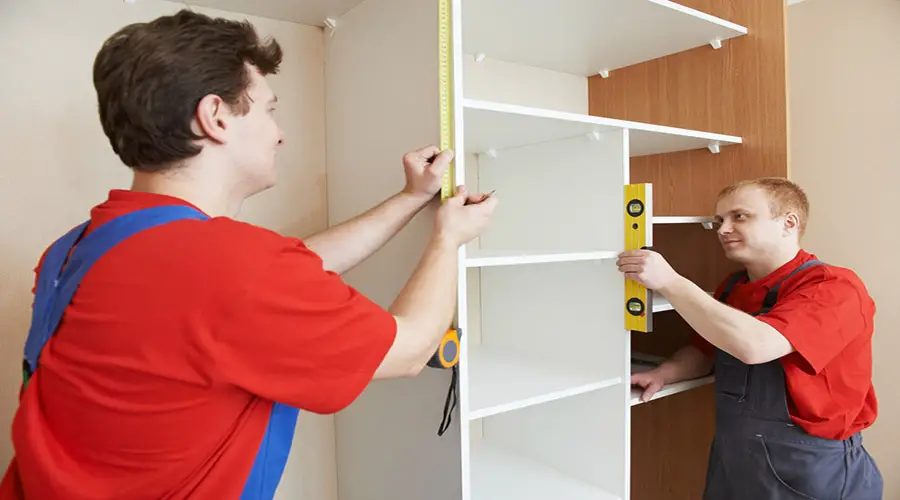
Are you planning to build a new home or renovate what you already have? If so, then it’s time to start thinking about the closets. These tips and questions will help you make the best decision to create a masterpiece closet.
When it comes to designing a closet, we recommend the following measurements:
| Shelves and Rods | Measurement |
|---|---|
| Shelf height | 60 to 98 inches |
| Shelf depth | 11 to 15 inches |
| Single rod height | 60 inches |
| Double rod height | 80 inches top, 40 inches bottom, 3 feet apart |
| Rod depth | 12 inches away from the closet walls |
| Rod with Top Shelf | 54 inches for rod, 60 inches for top shelf |
- Shelf height: we recommend a top-shelf height between 60 and 96 inches from the floor and a minimum of 12 inches below the ceiling. The shelf should also be located at least a foot from the closet ceiling. When placing two or more shelves, we recommend they be 12 inches apart, with the bottom shelf at least 16 inches above the floor.
- Shelf depth: we recommend shelf depth be between 11 and 15 inches deep.
- Rod Height: the standard rod height for a single closet rod is 60 inches. When installing double rods, we recommend the top rod be hung 80 inches from the floor and the bottom rod 40 inches from the floor. We recommend spacing the rods 3 feet apart.
- Rod Depth: the closet rod should be 12 inches away from the closet’s back wall.
- Rod with Top Shelf: we recommend the rod be at least 54 inches above the floor space and the top shelf at 60 inches.
Get FREE quotes from the best local handyman services in your area today. Whether you need a ceiling fan installed, a fence mended, closet or garage organization, minor painting, etc., We Can Help! All handyman services are screened, licensed, and insured.
Rods & Shelves Height Tips
There’s a lot of debate about the perfect height for rods and shelves in your home. There are many opinions on this topic, with no one right or wrong.
But there is one thing that you can be sure of: the most important person in determining what is best for your space is you!
Finding the right balance between practicality and personal preference will make the difference in finding an arrangement that works best.
So grab a measuring tape, consider these tips below consideration, and learn how to get those pesky things just where you want them!
Tip 1: Measure your Space First
Before going ahead and selecting the rods and shelves to install, you need to know what you are working with.
This enables you to get the right-sized accessories and lengths of both the rods and the shelves.
Tip 2: Plan the Design of the Closet You Want
There are two main kinds of closets that you can have in the home. You can have walk-in closets and reach-in closets. And the one you select depends on the space you have to spare for the wardrobe.
The walk-in could be something like half your bedroom, and the reach-in closet is the one that can fit snuggly on the corner of the room.
In retrospect, a walk-in closet consists of several reach-in closets, some with doors some without. And since the main focus is on height in this section, the ideal height would be from the floor to the roof. And this is mostly around 8 feet.
Yet again, placing the rods too high might be a bad idea for practicality. So instead, partition your closet by using shelves and have the rods at a height you can easily reach. Say 5′ above ground.
Tip 3: Select the Dimensions of the Closet Types You Choose
Walk-in closets have no standard sizes since each one you build will be unique. Regardless, builders follow general guidelines across the board making them.
Walk-in closets are essentially a combination of reach-ins. These are some of the dimensions that builders consider:
- Long rectangles measuring 48-inches wide
- 6 feet long
- 24 inches deep
- 80-inch high door
Rods & Shelves Spacing Tips
If your rods and shelves are too close together, the clothes will be squeezed and won’t have room to breathe. And so, getting the spacing right is very vital. You might want to try these spacing tips to get to that optimal spacing dimension.
Tip 1: Consider Who Will Be Using Those Shelves and Rods
Men and women have different needs when it comes to closet space. Women have dresses that can be short fitting in small spaces. And they also have long bulky ball gowns that are delicate, and needing more space.
On the other hand, men have suits that they have to store well too. And this is in addition to their shirts, shorts, and t-shirts, among others.
These pieces have to breathe, and here are some of the measurements you need to have in mind for each type of clothing:
Women:
| Clothing | Measurement |
|---|---|
| Dress | 68″ long |
| Robe | 52″ long |
| Jacket | 36″ long |
| Blouse on hanger | 34″ long |
| Folded Blouse | 10″ wide 13″ long |
| Skirts | 36″ long |
| A pair of shoes | 9 ½” long |
| Folded sweater | 10″ wide 14″ long |
Men:
| Clothing | Measurement |
|---|---|
| Suit coat | 12″ wide, 38″ long |
| Hanged Shirts | 12″ wide, 38″ long |
| Folded shirt | 8″ wide, 14″ long |
| Pants straight on hanger | 44″ long |
| Pants folded half on a hanger | 27″ long |
| Dress hat | 6″ high by 11″ round |
| A pair of shoes | 9″ to 12″ long |
| A pair of boots | 11″ wide, 12″ long |
Tip 2: Consider Single or Double Rod Systems
When looking at the spacing of your closet, you have to consider the hanging items and the pieces you store folded. From the table above, you can see that we have given every piece of clothing a standard dimension where they can fit without you squeezing them.
On that note, the rods you may install may be single or a double rod closet system. Single poles are best to hang the long clothing items with a minimum length of 5 feet on top of the rod. You can install two narrow shelves.
Regarding the double rod closet system installation, you only install one shelf at the very top. Then follow with two frames, a 3 feet spacing from one to the next. These are ideal for hanging short clothing like folded suits, shirts, and blouses.
Tip 3: Ensure the Clothes Do Not Touch the Floor
Whenever you are looking at the spacing of your closet, the most important tip is to ensure that the hanging pieces do not touch the floor.
The contact makes your clothes soak any extra moisture from the floors. They can also get dirty fast if the floor has dirt and dust.
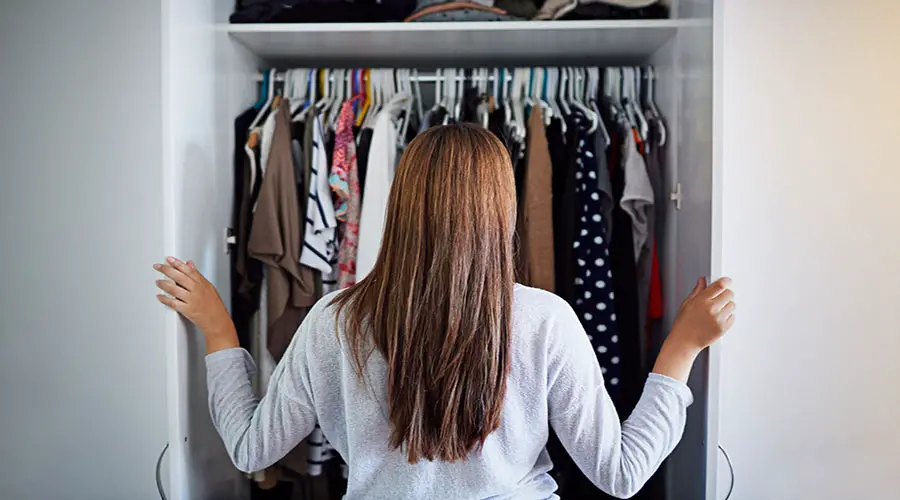
Rods & Shelves Design Tips
Have you ever had trouble deciding on the best rod and shelf combinations for your home? Are you unsure what to look for when picking a new closet design? No need to worry; we’re here to help.
Here are the best tips and tricks on how to go about finding that perfect setup. You’ll need an expert in no time at all.
Tip 1: Have a Functional Layout in Mind
There are several types of closet layouts, and here are some designs that most homeowners install, plus their components. You have to note that designing these shelves and rods in each category is entirely dependant on you, plus the space you have.
| Layout | Components |
|---|---|
| Single closet rod | One heavy-duty closet pole. Closet packages pole sockets |
| Single adjustable closet rod | One adjustable closet rod |
| Bi-level closet rod | Two heavy-duty closet poles. Two packages closet pole sockets |
| Bi-level closet rod with integrated shelves | Two heavy-duty closest poles. Two packages closet pole sockets Two shelf brackets with pole support One wooden shelf board |
| Single closet rod with integrated shelving | Two heavy-duty closet poles Two packages closet pole sockets Two brackets with pole supports One wooden shelf board |
| Single closet rod with shelving | One heavy-duty closet pole One packages closet pole socket One shelf bracket with pole support tFive wooden shelf boards Ten heavy-duty shelf brackets One heavy-duty end caps |
| Multiple closet rods ith shelving( for walk-in closets) | Four heavy-duty closet poles Two packages closet pole sockets Eleven shelf brackets with pole supports Six wooden shelf boards Six heavy-duty shelf brackets One heavy-duty end caps |
Key:
- 48 inches maximum width without support brackets.
- 16 inches bracket spacing, maximum 32 inches.
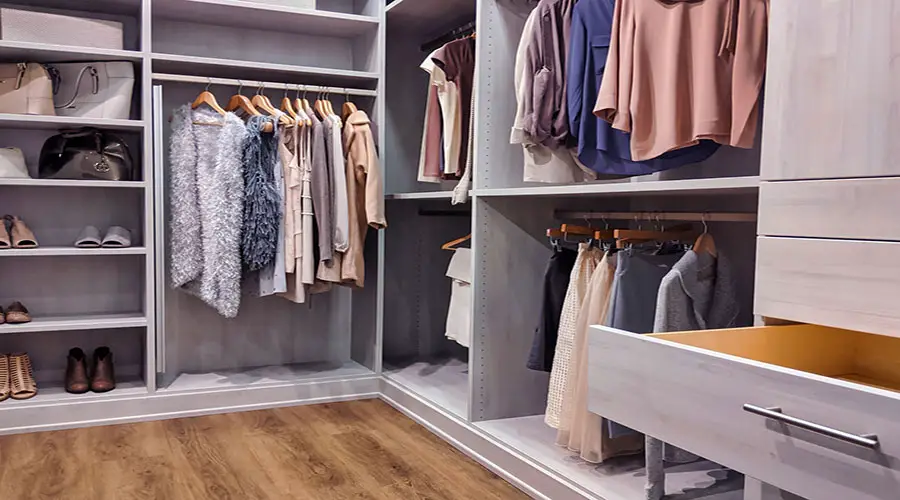
Tip 2: Design for Functionality and Visibility
Before jumping into the building, consider what you want to see at the end of the construction. And that is why the layout of the entire closet space is vital. Have a sketch and be practical to draw in sample clothing as well.
The result must be a wow factor and look appealing to the eye. So much so, design knowing that you will place what you use daily at arm’s length and the things you rarely use further back.
Tip 3: Closet Building Material Is Vital
The closet is mostly a closed space, so you need a breathable material and one that still looks amazing. You must also consider selecting material that is insect and pest repellant naturally. You would not like seeing moths, rats, or other bugs on your expensive suit.
So, go for functionality, durability, and sustenance despite going for face value. Cedar closet walls are the best so far. It repels moths and has impeccable water-resistant abilities. And it has an awe-inspiring visual appeal. Glass is also a good option, although it can be pricey. But if you can, why not?
If you do not want to go with transparent glass, there are many other tinted glasses or rigid plastic panels that you can use for the closet doors.
Tip 4: Go with Modern Closet Door Designs
Gone are the days when you only had the option of an open-shut style closet door. Now you may have folding or sliding doors perfect for small spaces. These closet door designs are very appealing.
You may even hide your closet in plain sight without anyone knowing there is a closet behind that wall. If you like this discreteness, paint the closet doors the exact hue of paint as the wall the closet doors link.
Tip 5: Lighting is Everything
A good closet, whether reach-in or walk-in, needs proper lighting. You need to see what you are selecting. So why not install lighting fixtures inside or outside the closet to see what you are picking?
Overhead bulbs in a walk-in closet may be sufficient as they light the entire room. The reach-in closet may have a bulb with a manual or automatic switch.
Frequently Asked Questions On Closets And Rods Answered
How Much Space Should Be Between The Closet Rod And Shelf?
A good rule of thumb is to measure the distance from your rod down to where you would like it positioned under a shelf.
It will usually be about ten inches, but this can vary depending on what size hangers and shelves you have available in the room or closet space.
How Far Apart Should Shelves Be In A Closet?
Spacing for shoe shelves about 6 to 7 inches apart. Spacing for shelves for folded clothes around 12-inches apart. This organizational system will provide ample space in your wardrobe to find what you need.
And this will also save you time looking through piles or drawers when getting dressed each morning.
What Is A Good Shelf Standard Depth?
A clothes closet should have a minimum depth of at least 24 inches deep so that the clothing can clear the back wall. Shelving depth is determined by what items you will most commonly store in it.
But generally, these pieces lie within 6-24 inches of space.
What Is Standard Shelf Depth?
The depth size you need depends primarily on whether you’re storing. Great examples are things like thin folded shirts or thick woolen sweaters, boxes, or shoes.
And since you do not want anything hanging over the edge, you need ample spacing. Shelves are usually 10-12 inches deep for general purposes and 8-12 inches wide.
How Do You Maximize Closet Shelf Space?
There are so many small ways to maximize the space on their closet shelves.
Here are some of them:
- Use organizational boxes to place specific items in each—for instance, a t-shirt box or a socks box.
- Use shelf dividers.
- Utilize under-shelf baskets.
- Utilize under-shelf hooks.
How Long Can Closet Rods Go Without Support?
The answer depends on the length of the rod and what the rod carries. Closet Rods are available in custom lengths up to 96 inches. And you require center support for beams longer than 48 inches.
Experts recommend additional supports if the closet rod needs to carry heavy apparel like winter coats, heavyweight suits, and the rest.
How Much Weight Can A Closet Rod Hold?
You can’t know the weight load a hanging rod will hold because it depends on its shape and the material that makes it. You could be able to hang 45 pounds worth of clothing when using oval aluminum but 170 if you use steel.
How Far From The Wall Should A Clothes Rod Be?
A typical convention is 12 inches from the back closet wall or centerline rod. This will hold a myriad of items in their place. If you want more space between them and don’t risk sacrificing some hanging length, measure 24 inches. But if not, this distance should be enough.
Hanging garments that extend past the edge can also get caught on other clothes when they are pulled out and closed up again, so keep good spacing as well – both horizontally across rows, and vertically down columns. The standard is a hanger every 3-4 inches, and never put anything too low because it’s easy to knock things over by mistake.
How Do You Fix A Closet Shelf That Sags?
To ensure your shelves are level, take these three simple steps:
- Place the metal bracket in the center of any frame and line it up with another.
- Mark where they meet on both brackets using a pencil to trace each side’s position.
- Remove that sagging middle shelf and neighbor below it for now because you’re about to mount new drywall anchors into these two spots you just marked.
How Do You Fix A Closet Rod That Sags?
You can use a support bracket to stabilize your rod by sliding the brackets under the rods and holding them in place against your wall. Lift on one end of the rod with both hands, ensuring that you have it well secured before releasing any pressure from either hand.
Then adjust so that there is no sag at all – this will ensure that everything stays straight for as long as possible. Use a spirit level to ensure you have a straight rod.
How Wide Should A Closet Be If You Want To Hang Clothes On Both Sides?
A minimum of 6 feet of space will work for your clothes because you’ll have two feet of hanging room on each side with space in between.
Final Thoughts
We all want to have that dream closet! But, before anyone gets started on designing their new space, there are a few things you’ll need.
First and foremost is an organized plan for how your clothes will hang– this includes getting the right-sized rods and shelves. What follows is the measurement, spacing, and design.
It’sIt’sential to use all the tips we have mentioned above when deciding on minimum height, spacing, and design because they can make or break the entire project.
So if you want your closet transformation to be successful, take some time to figure out what works best for you based on these three factors. Once you know where everything should go to maximize storage capabilities, get experts to help you.
Get FREE quotes from the best local handyman services in your area today. Whether you need a ceiling fan installed, a fence mended, closet or garage organization, minor painting, etc., We Can Help! All handyman services are screened, licensed, and insured.


